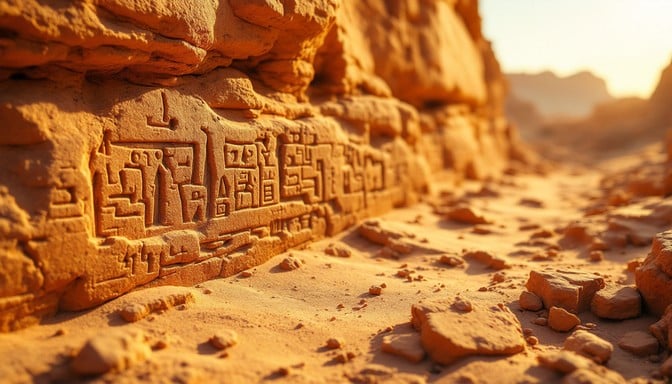When people think of cart ruts, their minds often travel to the rugged landscapes of Malta, the rocky hills of Sardinia, or the windswept cliffs of the Azores. But surprisingly, cart ruts in the USA tell a story just as compelling, stretching from the ranch-lands of Texas to the deserts of Arizona and the mountain passes of California. These mysterious parallel grooves—etched into stone, preserved in hardened soil, or imprinted in ancient trails—offer a tantalizing bridge between Old World mysteries and the vast, untamed landscapes of North America.
The existence of such features in the USA raises intriguing questions: Are these purely historic wagon tracks from the era of westward expansion, or could some of them hint at far older origins, echoing patterns found across the globe?
Texas: The Chisholm Trail and Beyond
In Texas, cart rut-tracks impressions are famously found along the Chisholm Trail, a 19th-century cattle-driving route that stretched from the southern plains to Kansas railheads. While most ruts here are historically linked to wooden-wheeled wagons cutting into the clay and limestone, some segments bear uncanny resemblance to ancient stone-cut tracks from Europe and Asia. Over time, erosion and repeated passage deepened these grooves, leaving behind enduring impressions.
Memorial Park in Round Rock, TX is known for a somewhat ‘Round Rock’ protruding out of Brushy Creek, which served as a low-water mark for Native Americans and European settlers to assess if the creek was safe to cross. However, the park is not well known for its 3 pairs of historic and possibly ancient cart ruts. Nearby in Austin, local rock outcrops and rural trails also display parallel wear marks—features which, though largely attributed to pioneer or agricultural use, evoke the same visual mystery that fascinates researchers worldwide. Bull Creek Park located in Austin, TX has two pairs of ruts in its creek bed. These ruts are very similar to those in Round Rock. The creek at this site has steep banks and a small waterfall upstream that would make it nearly impossible to traverse with a heavy wagon. Further downstream were what appeared to be submerged ruts that resembled those at Memorial Park.
Arizona: Penitente Canyon and White Cliffs
Arizona’s Penitente Canyon hides a series of parallel tracks carved into sandstone. Their depth and precision have inspired speculation: were these purely the result of historic freight wagons, or could they follow routes much older than European settlement? In White Cliffs, deep wagon trails are etched into the rocky surface—frozen in time, as if the last caravan rolled through only yesterday.
These Arizona examples are particularly striking because of their resemblance to Maltese cart ruts, where similar sandstone geology makes for crisp, enduring impressions.
California: Sherwin Grade and the Sierra Routes
The steep ascent of Sherwin Grade in California preserves wagon tracks from 19th-century pioneers braving the Sierra Nevada. Yet, some of these grooves cut surprisingly deep into the surface, suggesting repeated heavy use over decades—if not centuries.
California’s varied topography, from mountain passes to desert flats, offers fertile ground for discovering and preserving such markings. They may be historic, but they feed into the broader cart rut mystery by showing how similar features emerge under similar human and environmental pressures.
A Global Pattern?
What makes the cart ruts in the USA so fascinating is how they parallel examples thousands of miles away. From the Mysterious Cart Ruts Image Gallery to the submerged tracks documented in Mysterious Cart Ruts Underwater, similar grooves appear across continents, climates, and cultures.
Researchers exploring Cart Ruts Worldwide: A Common Culture? have noted a recurring pattern: parallel channels between 1.2–1.4 meters apart, often deeply worn into rock. Whether caused by wheeled transport, sledges, or some now-forgotten technology, the consistency is striking.
Could it be coincidence? Or do these parallel lines hint at a lost global tradition of travel and transport?
The American Connection to Ancient Tracks
In many cases, American cart ruts are tied to documented 18th- and 19th-century history. Yet the resemblance to older tracks elsewhere invites deeper comparative study. For example:
-
Were certain indigenous or pre-colonial routes modified by later settlers in ways that preserved ancient grooves?
-
Could geological processes have preserved certain tracks far longer than assumed?
-
Is there an unrecorded technological tradition that spans continents?
The more we study the USA’s cart ruts, the more they act as a bridge between well-documented history and deeper archaeological mystery.
Questions for Future Research
Any comprehensive study of cart ruts in the USA should consider:
-
Geological Comparisons — How does the stone and soil composition in American sites compare with classic cart rut regions like Malta or Anatolia?
-
Dating Techniques — Could modern dating methods (e.g., optically stimulated luminescence) pinpoint the age of track surfaces?
-
Route Mapping — Do the tracks align with indigenous pathways or geological corridors used for millennia?
-
Cultural Overlap — Could parallels between American and Old World cart ruts suggest shared knowledge or convergent solutions to transport challenges?
Connecting the Series
This article forms part of ANCIENT360’s ongoing series exploring the global cart rut mystery. For a broader perspective, you can explore related articles:
Conclusion
From Texas cattle trails to Arizona sandstone paths and California’s mountain passes, cart ruts in the USA are more than just relics of pioneer days—they’re part of a worldwide enigma. Whether purely historic or echoing something far older, they challenge our understanding of travel, technology, and the persistence of human pathways.
In the end, the USA’s cart ruts invite us to walk in the grooves of history—across continents, across centuries, and perhaps across civilizations themselves.

Additional interesting read: https://www.cartruts.de/





